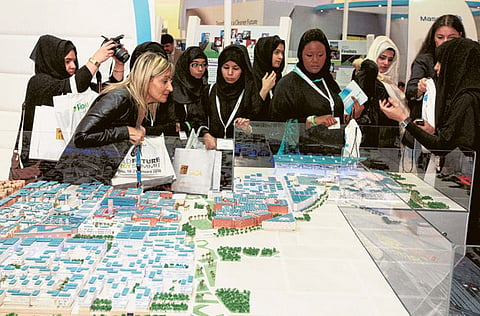Asia strives to increase energy efficiency
Growing Chinese and Indian middle classes to drive energy demand

Abu Dhabi: Measures are being taken around Asia to cope with the massive increases in demand for energy expected in the next 20 years, a panel in the capital heard yesterday.
The panel, part of the second day of sessions at the four-day World Future Energy Summit, was convened to discuss sustainable environment solutions around the world.
According to data presented at the panel, 93 per cent of all urban growth until 2030 will take place in developing nations, with 80 per cent of the growth taking place in Asia and Africa. More specifically, there will be 70 cities in India by 2020 that will each have about a million population.
Moreover, 20 per cent of all global energy demand in 2030 will come from China.
The panel heard that seven cities in China are largely solar-powered, and Dezhou uses it to generate 90 per cent of the energy it consumes.
Mili Majumdar, associate director of sustainable building resources at The Energy Resources Institute in India, and one of the speakers at the panel, presented the outlook for India.
"We expect our population to increase to about 1.4 billion people by 2025 and since most people will be part of the middle class by 2016, we have extensive energy demands," Majumdar explained.
"The federal government is therefore implementing a new plan called GRIHA, which encourages and incentivises energy efficiency," she told Gulf News.
This new initiative is aimed at reducing energy consumption in both domestic and commercial buildings, Majumdar said.
Level of compliance
"Depending on the level of compliance, the government offers monetary incentives. For example, the government will cover the rating assessment costs for the first 100 buildings which follow the GRIHA standards.
"Also, government buildings can claim 90 per cent of these costs if they meet the standards," she said.
Five million square metres of urban area are to be made energy efficient in India by 2012, and the government is also working on a plan to conserve energy in existing buildings.
A speaker from Japan described plans for a zero net energy building.
A building of this kind is 100 per cent self-sufficient in terms of energy because it uses a double skin of shading and insulation, in addition to greening areas as well as the technology of a traditional Middle Eastern wind tower.
The buildings are most efficient at the one-storey level, which is feasible in the Middle East with its availability of land, but can also be built to up to three storeys. Kentaro Kawaguchi, senior architect and project director of Eco Sky House, Mitsubishi Heavy Industries, told Gulf News that there were about 100 buildings of this kind in Japan.
"We are not sure of the cost of the building in the Middle East because it depends on the type of lithium battery to save power for energy generation at night. We are looking for collaborators," Kawaguchi said.
Sign up for the Daily Briefing
Get the latest news and updates straight to your inbox


